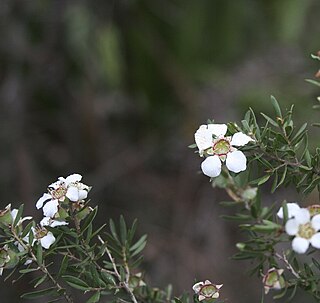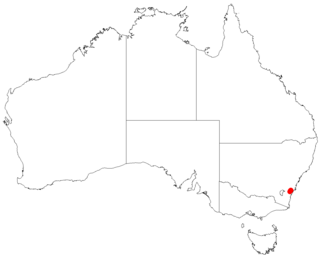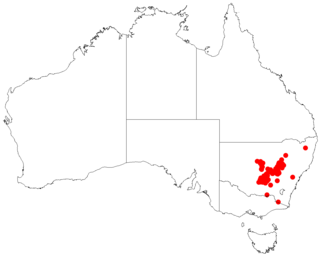
Leptospermum squarrosum, commonly known as the peach blossom tea-tree, is an upright shrub of the family Myrtaceae and is endemic to central eastern New South Wales. It has thin, firm bark, broadly lance-shaped to elliptical leaves, relatively large white or pink flowers and fruit that remain on the plant when mature.

Leptospermum continentale, commonly known as prickly tea-tree, is a species of slender, straggling shrub that is endemic to south-eastern Australia. It has sharp-pointed, narrowly egg-shaped leaves, white flowers arranged singly in leaf axils and woody fruit that remains on the plant when mature.

Leptospermum juniperinum, commonly known as the prickly tea tree, is a species of broom-like shrub that is endemic to eastern Australia. It has narrow, sharply pointed leaves, white flowers usually arranged singly on short side shoots and small fruit that remain on the plant when mature.

Leptospermum deuense is a species of shrub that is endemic to New South Wales. It is a leafy, densely branched shrub with rough bark on the older stems, elliptical leaves with a glossy upper surface, white flowers arranged singly or in pairs and woody fruit.

Leptospermum coriaceum, commonly known as green tea-tree or mallee teatree, is a shrub species that is endemic to south-eastern Australia. It has smooth bark on the younger stems, elliptic to narrow egg-shaped leaves, white flowers and woody fruit. The usual habitat is mallee on sand dunes.

Leptospermum multicaule, commonly known as the silver tea-tree, is a species of shrub that is endemic to south eastern Australia. It has linear, narrow elliptical or narrow egg-shaped leaves, white or pink flowers usually borne singly on short side shoots, and fruit the falls from the plant soon after the seeds are released.

Leptospermum argenteum, commonly known as the Mt Royal tea-tree, is a species of shrub that is endemic to the higher parts of Barrington Tops in New South Wales. It has smooth bark, stems with a flange along the sides, broad leaves, white flowers and unlike many others in the genus, it is never lemon-scented.
Leptospermum benwellii is a species of shrub that is endemic to the Nymboida National Park in New South Wales. It has smooth bark, young branches with conspicuous flanges, narrow elliptical leaves, white flowers and thin-walled, bell-shaped to hemispherical fruit.

Leptospermum blakelyi is a species of shrub that is endemic to rocky clifftops near Lithgow in New South Wales. It has densely silky young stems, egg-shaped to elliptical leaves and white or pink flowers.

Leptospermum brachyandrum is a species of shrub or small tree that is endemic to eastern Australia. It has smooth bark, linear to lance-shaped leaves and white flowers and usually grows along creeks, often in water.

Leptospermum brevipes, commonly known as the slender tea-tree, is a species of shrub or small tree that is endemic to eastern Australia. It has fibrous bark on the main stems, smooth bark on young stems, narrow elliptical to narrow egg-shaped leaves, white flowers and hemispherical fruit that is shed when mature.

Leptospermum crassifolium is a species of shrub that is endemic to the Budawang Range in New South Wales. It has thin, rough bark that is shed annually, broadly elliptic leaves, white flowers borne singly on short side branches, and woody fruit.

Leptospermum divaricatum is a species of plant that is endemic to inland New South Wales. It is an erect or weeping shrub with compact fibrous bark, elliptical to egg-shaped leaves, white flowers arranged singly on short axillary side shoots and woody fruit that fall off when mature.
Leptospermum microcarpum is a species of shrub that is endemic to eastern Australia. It has elliptical to lance-shaped leaves with a sharp point on the tip, white flowers and small fruit that falls from the plant shortly after the seeds are released.

Leptospermum sejunctum is a shrub that is endemic to the Nowra district in New South Wales. It has thin, grey bark, lance-shaped to elliptical leaves, white flowers and fruit that remain on the plant at maturity.

Leptospermum semibaccatum is a species of low, dense shrub that is endemic to eastern Australia. It has egg-shaped to narrow elliptical leaves with a blunt tip, white or pink flowers and hairy, flat-topped fruit that falls from the plant shortly after the seeds are released. It grows in poorly-drained soil in coastal heath.
Leptospermum speciosum is a species of shrub that is endemic to eastern Australia. It has pale bark that is shed in strips, broadly lance-shaped to elliptical leaves, white flowers arranged singly or in groups of up to three in leaf axils, and small, woody fruit that falls off when mature.

Leptospermum sphaerocarpum is a species of shrub that is endemic to New South Wales. It has thin, firm bark, elliptical, sharply-pointed leaves, greenish white or pink flowers and fruit that remain on the plant at maturity.

Leptospermum variabile is a species of shrub that is endemic to eastern Australia. It has thin, rough or scaly bark, broadly elliptical to lance-shaped leaves with the narrower end towards the base, white flowers arranged singly on the ends of short side branches, and woody fruit that remains on the plant when mature.
Leptospermum whitei is a species of shrub that is endemic to eastern Australia. It has fibrous, flaky bark, elliptical leaves, white flowers arranged in small groups on the ends of short side branches, and fruit that falls from the plant when mature.



















